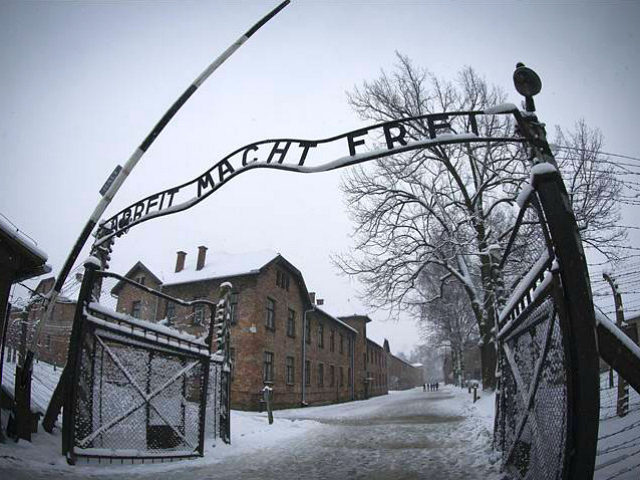General Hans Kammler, a Nazi SS commander who designed the Third Reich’s network of concentration camps and V-2 rocket program, likely escaped Europe with aid from the U.S. government in exchange for intelligence. This was explained by Dean Reuter, general counsel, vice president, and director of the Practice Groups of the Federalist Society for Law and Public Policy and co-author of The Hidden Nazi: The Untold Story of America’s Deal with the Devil, during a Wednesday interview on SiriusXM’s Breitbart News Daily with host Alex Marlow.
“[Hans Kammler] is the guy who identified Auschwitz as the place for the biggest camp and then he designed Auschwitz, including metes and bounds, the irrigation system, the roadways,” said Reuter. “He even designed the standard concentration camp barracks.”
LISTEN:
Kammler directed Nazi construction of concentration camp barracks to use wood instead of stone in order to accelerate prisoner deaths via the elements while reducing costs, Reuter noted, further highlighting Kammler’s taking of measures in camp design to increase the spread of disease among inmates.
Reuter stated, “[Hans Kammler] became known for these efficiencies [and] standardization in processes and materials and designs [for the purposes of] killing machinery. … He was a hands-on sort of guy. He wasn’t doing this from Berlin from some bureaucratically safe place. He was on the ground. We have documents [of his] weekly and daily visits to these camps.”
“[Hans Kammler] literally made the Holocaust possible,” Reuter determined. “Not only did he design these camps. … He’s the guy who decided, ‘We’re going to have a gas chamber near the basement near the railroad tracks that approach the camp, because it’s the infirm, the elderly, [and] the children that [we’re] gassing first, so make it as efficient as possible, and then we’ll have an elevator upstairs to the crematoria to reduce the distance that the corpses had to be traveled.”
“[Hans Kammler] perfected … terrible and aberrant behavior,” Reuter remarked. “He did for concentration camps and mass killing what Henry Ford did for automobiles, in terms of mechanizing it, standardizing it, and making it grossly efficient.”
Reuter shared some of his research into tracing Kammler’s post-war fate.
“If it was known that Hans Kammler had survived, I think he would have been number one on the most wanted list,” estimated Reuter. “There are some difficulties in trying to figure out [what happened to Hans Kammler]. We have traced him to March of 1946. So, eight months after the war, we had him. Ten months after the war, the United States had him in custody. We interrogated him about various things in various places in northern Austria, [and] central Germany on the eve of the Nuremberg trial, and I think we got everything we could from him.”
Reuter shared three possible post-war outcomes for Kammler.
“[Hans Kammler] might have gone to the United States,” speculated Reuter. “That’s sort of the worst-case [and] most frightening scenario for most of our readers. He could have stayed on the continent with aid from the United States, but what we deem the most likely scenario is he went to South America with assistance from the United States, and we come to that conclusion — and back it up, I think, really well — based on other known cases.”
Reuter continued, “There were other cases that became known. One in particular, Klaus Barbie, the ‘Butcher of Lyon.’ He’s as bad as you can get, but again, operated on a small scale [than Hans Kammler] in terms of his geography during the war. At the end of the war, the U.S. Army Counterintelligence Corps recruited him as an intelligence asset because he knew the Soviets. We used him for years as an intelligence asset. The French wanted him. He’d already been tried in absentia and found guilty and sentenced to death, so we’re using a capital war criminal as an intelligence asset. The French wanted him [and] we wouldn’t give over. Finally, the pressure got so high that we shipped him to South America.
Certain records from the U.S. Army Counterintelligence Corps [Army CIC], a WWII-era military intelligence agency, are lost or destroyed, Reuter said. “Their records from 1945 to 1947 — from one particular geographical unit that we were concerned with — are gone. They just do not exist, we’re told.”
The Office of Strategic Services [OSS], the precursor to the CIA, also lost or destroyed documents of interest to Reuter’s research. At the end of the war, five million pages of their documents were destroyed,” stated Reuter.
“There’s even a consideration in the book that [Hans Kammler] was even scarier than Hitler,” stated Marlow. “Is that even possible? Could [he] be more ruthless?”
“I think so,” replied Reuter “Yes. … Hitler was a mastermind. He was a psychopath. I think, probably, Hammler was, as well, but there were things that we found that Kammler was willing to do that Hitler was not, and I’m talking about things that went beyond, like the use of chemical and biological weapons, the possible use of nuclear weapons. Hitler didn’t want to use those. It’s clear that Kammler, without Hitler’s knowledge, was working that direction, sort of behind the scene, in secret.”
Reuter also explained how the post-war race between the U.S. and Soviet Union for Nazi-developed rocket technology was central to determining the Cold War’s outcome.
Breitbart News Daily broadcasts live on SiriusXM Patriot 125 weekdays from 6:00 a.m. to 9:00 a.m. Eastern.
Follow Robert Kraychik on Twitter.

COMMENTS
Please let us know if you're having issues with commenting.